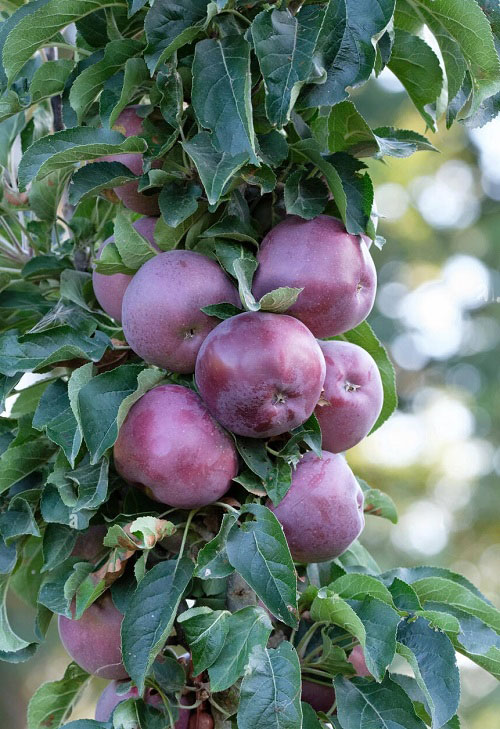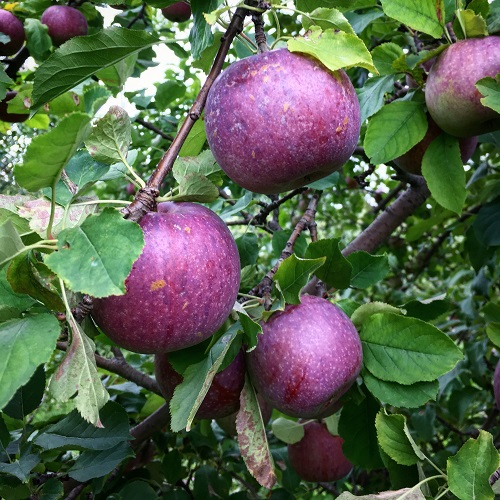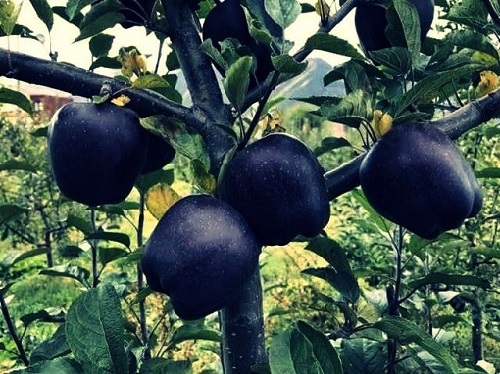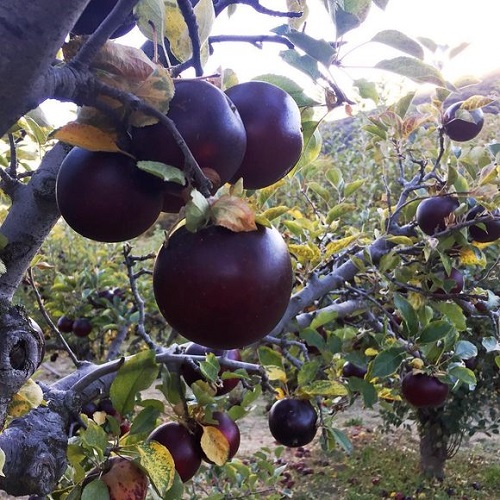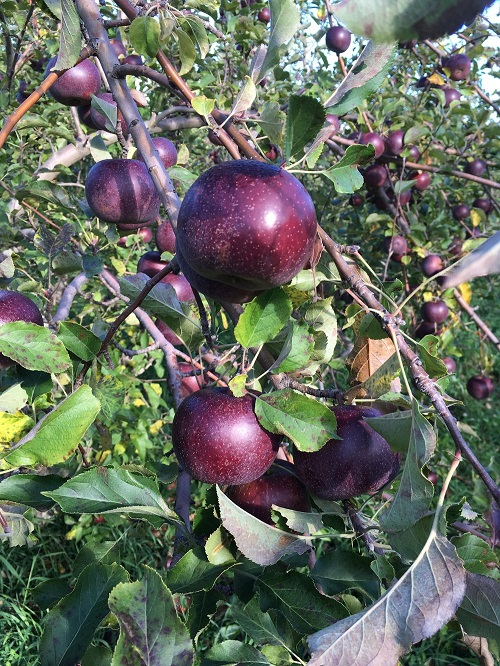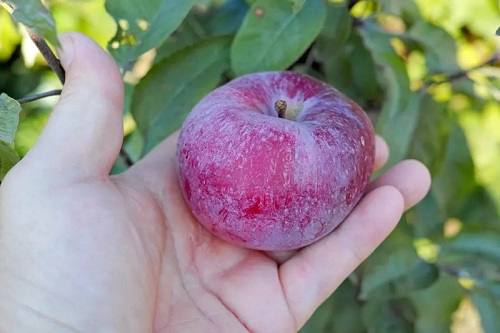Here are the Best Blue Apple Varieties with amazing Facts and Growing Information so you can start growing these beauties in your home!
Ever wondered – Do blue apples exist? Don’t worry! We’ve got you covered with the best guide on the Best Blue Apple Varieties, complete with Facts and Growing Information.
Blue Tulip Meaning | 4 Best Blue Tulips Varieties
Does Blue Apple Exist?
Yes, blue apples do indeed exist, and their presence is as captivating as it is intriguing! Their distinctive appearance owes its allure to a natural pigment called anthocyanin, which also graces a variety of other vibrant fruits and vegetables.
While the color might not be a perfect blue in the traditional sense, this remarkable pigment has the power to imbue shades that span from deep purplish-red to a strikingly dark almost-black.
Check out Fruits that can be Grown in Shade Here
Blue Apple Taste
The taste of blue apples offers a captivating array of flavors that vary across different apple varieties, adding an element of surprise to each bite.
Blue apples come in different flavors depending on the type you try. They can be a bit sweet or a little sour, just like regular apples. Even though they look special with their blue color, their taste is mostly similar to what you expect from apples.
From the Blue Pearmain to the Black Oxford, you can relish all blue apple varieties raw or cooked, but each kind of blue apple has its own special taste.
Red Custard Apple Tree Care and Growing Information
Best Blue Apple Varieties
Here are a few more apple varieties that may exhibit bluish tones. Do not that few of these varieties may not have the ‘pure blue’ tint that you may imagine!
1. Blue Moon
This apple variety has a bluish-purple skin with a hint of pink or reddish blush. It’s known for its sweet flavor and distinctive appearance.
2. Blue Pearmain
The Blue Pearmain apple is a heritage blue apple variety known for its distinctive blue-green skin and sweet, mildly tart flavor, making it a favorite for fresh eating and cooking. It can also have some red and yellow hues but becomes darker as it matures.
3. Black Diamond Apple
The Black Diamond apple is a rare and visually striking variety with dark blue, almost black skin, revealing crisp, white flesh beneath its alluring exterior.
Check Best Blue Flowers For the Garden here
4. Arkansas Black Apple
Another of the best blue apple varieties, the skin of this one has a waxy texture and tends to become darker as the apple matures. Initially quite tart, the Arkansas Black’s flavor mellows over time.
Apple Fact: Did you know? The Arkansas Black Apple has exceptional storage quality. When stored in cool and dry conditions, it can last for several months without significant loss of quality. Over time, the flavor continues to evolve, with the apple becoming sweeter and more flavorful.
5. Black Oxford Apple
The Black Oxford apple stands out with its intriguing deep purple-black skin, a distinct departure from traditional apple hues, making it a visually captivating addition to orchards and gardens.
6. Burgundy Apple
The Burgundy blue apple charms with its rich, reddish-maroon skin that adds a touch of elegance to orchards while offering a pleasing inner texture. Although not blue, the deep red color might appear as a blue-black hue under certain light conditions.
How to Grow Giant Strawberries | Big Strawberry
How to Grow a Blue Apple Tree
Growing a blue apple tree is similar to cultivating other apple varieties. The term “blue apple” generally refers to apple varieties that may exhibit a dark, purplish-red, or almost black hue rather than a true blue color.
Below are steps to grow an apple tree from one of these unique varieties, such as the Black Diamond or Blue Pearmain:
1. Selecting the Right Variety
Choose an apple variety that has the bluish or dark hue you desire. Consult local nurseries or online suppliers that specialize in unique apple varieties.
Variegated Banana Plant Varieties
2. Finding the Perfect Location
Select a sunny spot with well-drained soil. Apple trees prefer full sun, and the location should receive at least 6-8 hours of sunlight daily.
3. Soil Preparation
Test the soil pH; it should be between 6.0-7.0. Amend the soil with compost or other organic matter if needed to improve drainage and fertility.
4. Planting the Tree
- Dig a hole twice as wide and as deep as the root ball. Remove the tree from its container and gently loosen the roots.
- Place the tree in the hole, ensuring that the graft union (if present) is above soil level.
- Backfill the hole, tamping down the soil to remove air pockets.
- Water the tree thoroughly.
5. Watering and Feeding
- Water regularly during the first year, especially during dry periods.
- Apply a balanced fertilizer in early spring, following the manufacturer’s instructions.
How To Water Plants + 5 Watering Mistakes You’re Doing
6. Pruning
- Prune the tree during its dormant period (late winter to early spring).
- Remove dead, diseased, or crossing branches to encourage healthy growth.
7. Pest and Disease Management
Monitor for common apple tree pests and diseases and treat them as needed, following guidelines for organic or conventional treatments.
8. Harvesting
The apples will generally be ready for harvest in late summer to early fall, depending on the variety. The color and flavor will be your guide to ripeness.
9. Winter Care
In colder climates, consider mulching around the base of the tree to protect the roots from freezing temperatures.
Frequently Asked Questions
1. What Are Blue Apples?
Blue apples refer to certain apple varieties with a unique dark, purplish-red, or almost black hue. Some may even have a bluish tint or bloom on the skin.
2. Do Blue Apples Exist Naturally?
Blue apples are not truly blue, but certain varieties may have a hue that appears blue under certain conditions. These are naturally occurring.
Beautiful Trees With Blue Flowers here
3. Where Can I Buy Blue Apples?
Blue apple varieties may be found at specialty orchards, farmers’ markets, or gourmet food stores.
4. Can Blue Apples Be Grown at Home?
Yes, some of the blue-tinted apple varieties can be cultivated at home, though the specific coloration may vary based on the growing environment.
5. How Do Blue Apples Taste?
The flavor of blue apples can range from sweet to tart, just like traditional apple varieties. The color does not generally affect the flavor.
Different Types of Pink Fruits to Grow in Garden
6. What Can I Cook with Blue Apples?
Blue apples can be used in any recipe that calls for apples, such as pies, crisps, salads, and sauces.
7. Are Blue Apples Genetically Modified?
The blue apple varieties mentioned are not genetically modified but are naturally occurring.
8. What’s the Nutritional Value of Blue Apples?
Blue apples offer similar nutritional value as other apple varieties, including vitamins, fiber, and antioxidants.
Best Blue Rose Varieties + Blue Rose Meaning
9. How Should Blue Apples Be Stored?
Like other apples, blue apples should be stored in a cool, dry place, and refrigeration can extend their freshness.
10. Are There Specific Blue Apple Varieties?
Yes, some apple varieties like the Black Diamond and Blue Pearmain are known for their dark hue that can appear blue or almost black.
11. Can the Blue Color Fade?
The bluish tint may vary based on factors such as ripeness, storage, and light.

